Effect of Pre-Treatments on the Qualities of Banana Dried by Two Different Drying Methods
Abstract
:1. Introduction
2. Materials and Methods
2.1. Materials
2.2. Drying Methods
2.3. Preparation and Pretreatment of Bananas before Drying
2.4. Estimation of Thermo-Physical Parameters
2.4.1. Initial Moisture Content
2.4.2. Moisture (Mt)
2.4.3. Moisture Ratio
2.4.4. Drying Rate
2.5. Analytical Methods
2.5.1. pH Value
2.5.2. Total Acidity
2.5.3. Water Activity
2.5.4. Browning Index (Optical Density (OD) Measurement)
2.5.5. Rehydration Ratio
2.5.6. Reducing Sugar
2.5.7. Extraction and Determination of Total Phenol and DPPH
2.6. Sensory Evaluation
2.7. Cost Analysis
2.8. Statistical Analysis
3. Results
Costs Analysis
4. Conclusions
Author Contributions
Funding
Institutional Review Board Statement
Informed Consent Statement
Data Availability Statement
Acknowledgments
Conflicts of Interest
References
- Amini Khoozani, A.; Birch, J.; Bekhit, A.E.D.A. Production, application and health effects of banana pulp and peel flour in the food industry. J. Food Sci. Technol. 2019, 56, 548–559. [Google Scholar] [CrossRef] [PubMed]
- Abe-Inge, V.; Agbenorhevi, J.K.; Kpodo, F.M.; Adzinyo, O.A. Effect of different drying techniques on quality characteristics of African Palmyra palm (Borassus aethiopum) Fruit Flour. Food Res. 2018, 2, 331–339. [Google Scholar] [CrossRef] [PubMed]
- Doymaz, İ. Drying of green bean and okra under solar energy. Chem. Ind. Chem. Eng. Q. CICEQ 2011, 17, 199–205. [Google Scholar] [CrossRef]
- Zielinska, M.; Markowski, M. The influence of microwave-assisted drying techniques on the rehydration behavior of blueberries (Vaccinium corymbosum L.). Food Chem. 2016, 196, 1188–1196. [Google Scholar] [CrossRef] [PubMed]
- Amit, S.K.; Uddin, M.M.; Rahman, R.; Islam, S.M.; Khan, M.S. A review on mechanisms and commercial aspects of food preservation and processing. Agric. Food Secur. 2017, 6, 51. [Google Scholar] [CrossRef]
- Testa, R.; Rizzo, G.; Schifani, G.; Tinebra, I.; Farina, V.; Vella, F.; Migliore, G. Can dried fruits replace unhealthy snacking among millennials? an empirical study on dried fruit consumption in Italy. Sustainability 2023, 15, 7083. [Google Scholar] [CrossRef]
- Testa, R.; Schifani, G.; Migliore, G. Understanding consumers’ convenience orientation: An exploratory study of fresh-cut fruit in Italy. Sustainability 2021, 13, 1027. [Google Scholar] [CrossRef]
- Asioli, D.; Rocha, C.; Wongprawmas, R.; Popa, M.; Gogus, F.; Almli, V.L. Microwave-dried or air-dried? Consumers’ stated preferences and attitudes for organic dried strawberries. A multi-country investigation in Europe. Food Res. Int. 2019, 120, 763–775. [Google Scholar] [CrossRef]
- Sadler, M.J.; Gibson, S.; Whelan, K.; Ha, M.A.; Lovegrove, J.; Higgs, J. Dried fruit and public health—What does the evidence tell us? Int. J. Food Sci. Nutr. 2019, 70, 675–687. [Google Scholar] [CrossRef]
- Sun, Y.; Liang, C. Effects of determinants of dried fruit purchase intention and the related consumer segmentation on ecommerce in China. Br. Food J. 2021, 123, 1133–1154. [Google Scholar] [CrossRef]
- Sun, Y.; Liang, C. Factors determining consumers’ purchase intentions towards dried fruits. Int. J. Fruit Sci. 2020, 20 (Suppl. S2), S1072–S1096. [Google Scholar] [CrossRef]
- Cinar, G. Consumer perspective regarding dried tropical fruits in Turkey. Ital. J. Food Sci. 2018, 30, 809–827. [Google Scholar]
- Jesionkowska, K.; Sijtsema, S.J.; Konopacka, D.; Symoneaux, R. Dried fruit and its functional properties from a consumer’s point of view. J. Hortic. Sci. Biotechnol. 2009, 84, 85–88. [Google Scholar] [CrossRef]
- Sabbe, S.; Verbeke, W.; Van Damme, P. Familiarity and purchasing intention of Belgian consumers for fresh and processed tropical fruit products. Br. Food J. 2008, 110, 805–818. [Google Scholar] [CrossRef]
- Sijtsema, S.J.; Jesionkowska, K.; Symoneaux, R.; Konopacka, D.; Snoek, H. Perceptions of the health and convenience characteristics of fresh and dried fruits. LWT Food Sci. Technol. 2012, 49, 275–281. [Google Scholar] [CrossRef]
- Alphonce, R.; Temu, A.; Almli, V.L. European consumer preference for African dried fruits. Br. Food J. 2015, 117, 1886–1902. [Google Scholar] [CrossRef]
- Sehrawat, R.; Nema, P.K.; Kaur, B.P. Quality evaluation and drying characteristics of mango cubes dried using low-pressure superheated steam, vacuum and hot air drying methods. LWT 2018, 92, 548–555. [Google Scholar] [CrossRef]
- Izli, N.; Izli, G.; Taskin, O. Impact of different drying methods on the drying kinetics, color, total phenolic content and antioxidant capacity of pineapple. CyTA J. Food 2018, 16, 213–221. [Google Scholar] [CrossRef]
- Link, J.V.; Tribuzi, G.; Laurindo, J.B. Conductive multi-flash drying of mango slices: Vacuum pulse conditions on drying rate and product properties. J. Food Process. Preserv. 2018, 42, e13440. [Google Scholar] [CrossRef]
- Abul-Fadl, M.M.; Ghanem, T.H.; EL-Badry, N.; Nasr, A. Effect of puff drying on seedless grape fruits quality criteria compared to convective air drying. Al-Azhar J. Agric. Res. 2020, 45, 75–91. [Google Scholar] [CrossRef]
- Folaranmi, J. Design, construction and testing of simple solar maize dryer. Leonardo Electron. J. Pract. Technol. 2008, 1, 122–130. [Google Scholar]
- Ivanova, D.; Andonov, K. Analytical and experimental study of combined fruit and vegetable dryer. Energy Convers. Manag. 2001, 42, 975–983. [Google Scholar] [CrossRef]
- Nemzer, B.; Vargas, L.; Xia, X.; Sintara, M.; Feng, H. Phytochemical and Physical properties of blueberries, tart cherries, strawberries, and cranberries as affected by different drying methods. Food Chem. 2018, 262, 242–250. [Google Scholar] [CrossRef]
- Nabnean, S.; Janjai, S.; Thepa, S.; Sudaprasert, K.; Songprakorp, R.; Bala, B.K. Experimental performance of a new design of solar dryer for drying osmotically dehydrated cherry tomatoes. Renew. Energy 2016, 94, 147–156. [Google Scholar] [CrossRef]
- Varalakshmi, K. Role of conventional energy in rural development in India: Feasibility analysis of solar drying technology. Int. J. Energy Environ. Eng. 2016, 7, 321–327. [Google Scholar] [CrossRef]
- Soomro, A.H.; Miano, T.F.; Marri, A.; Kumar, D.; Khaskheli, G.S.; Arain, U.F.; Baloch, A.B. Application of pretreatments on banana slices for improving drying characteristics. Food Sci. Qual. Manag. 2020, 103, 35–41. [Google Scholar]
- Capecka, E.; Mareczek, A.; Leja, M. Antioxidant activity of fresh and dry herbs of some lamiaceae species. Food Chem. 2005, 93, 223–226. [Google Scholar] [CrossRef]
- Abano, E.E.; Sam-Amoah, L.K.; Owusu, J.; Engmann, F.N. Effects of ascorbic acid, salt, lemon juice, and honey on drying kinetics and sensory characteristic of dried mango. Croat. J. Food Sci. Technol. 2013, 5, 1–10. [Google Scholar]
- Deori, G.D.; Langthasa, S.; Hazarika, D.N.; Goswami, R.K.; Kalita, M.K. Effect of pretreatment on quality of minimally processed culinary banana cv. kachkal (ABB Group). J. Pharmacogn. Phytochem. 2020, 9, 2256–2262. [Google Scholar] [CrossRef]
- AOAC International. Official Methods of Analysis of the Association of Official Analytical Chemists International, 20th ed.; AOAC International: Rockville, MD, USA, 2016. [Google Scholar]
- Usub, T.; Lertsatitthanakorn, C.; Poomsa-ad, N.; Wiset, L.; Yang, L.; Siriamornpun, S. Experimental performance of a solar tunnel dryer for drying silkworm pupae. Biosyst. Eng. 2008, 101, 209–216. [Google Scholar] [CrossRef]
- Karthikeyan, A.K.; Murugavelh, S. Thin layer drying kinetics and exergy analysis of turmeric (Curcuma longa) in a mixed mode forced convection solar tunnel dryer. Renew. Energy 2018, 128, 305–312. [Google Scholar] [CrossRef]
- Araújo, C.d.S.; Macedo, L.L.; Vimercati, W.C.; Ferreira, A.; Prezotti, L.C.; Saraiva, S.H. Determination of pH and acidity in green coffee using near-infrared spectroscopy and multivariate regression. J. Sci. Food Agric. 2020, 100, 2488–2493. [Google Scholar] [CrossRef] [PubMed]
- Lewicki, P.P.; Lukaszuk, A. Changes of rheological properties of apple tissue undergoing convective drying. Dry. Technol. 2000, 18, 707–722. [Google Scholar] [CrossRef]
- Gabas, A.L.; Menegalli, F.C.; Ferrari, F.; Telis-Romero, J. Influence of drying conditions on the rheological properties of prunes. Dry. Technol. 2002, 20, 1485–1502. [Google Scholar] [CrossRef]
- Siddiqui, S.; Gehlot, R.; Arora, S.; Ahmed, N. Effects of Anti-browning pretreatments on browning of banana pulp. Int. J. Curr. Microbiol. Appl. Sci. 2018, 7, 242–249. [Google Scholar] [CrossRef]
- Dehghannya, J.; Kadkhodaei, S.; Heshmati, M.K.; Ghanbarzadeh, B. Ultrasound-assisted intensification of a hybrid intermittent microwave—Hot air drying process of potato: Quality aspects and energy consumption. Ultrasonics 2019, 96, 104–122. [Google Scholar] [CrossRef] [PubMed]
- Anjos, O.; Paula, V.; Delgado, T.; Estevinho, L. Influence of the storage conditions on the quality of bee pollen. Zemdirbyste 2019, 106, 87–94. [Google Scholar] [CrossRef]
- Alshallash, K.S.; Abolaban, G.; Elhamamsy, S.M.; Zaghlool, A.; Nasr, A.; Nagib, A.; El-Hakim, A.F.A.; Zahra, A.A.; Hamdy, A.E.; Taha, I.M. Bee pollen as a functional product—Chemical constituents and nutritional properties. J. Ecol. Eng. 2023, 24, 173–183. [Google Scholar] [CrossRef]
- Yu, G.; Bei, J.; Zhao, J.; Li, Q.; Cheng, C. Modification of carrot (Daucus carota Linn. var. Sativa Hoffm.) pomace insoluble dietary fiber with complex enzyme method, ultrafine comminution, and high hydrostatic pressure. Food Chem. 2018, 257, 333–340. [Google Scholar] [CrossRef]
- Akan, E.; Yerlikaya, O.; Akpinar, A.; Karagozlu, C.; Kinik, O.; Uysal, H.R. The effect of various herbs and packaging material on antioxidant activity and colour parameters of whey (lor) cheese. Int. J. Dairy Technol. 2021, 74, 554–563. [Google Scholar] [CrossRef]
- Gallali, Y.M.; Abujnah, Y.S.; Bannani, F.K. Preservation of fruits and vegetables using solar drier: A comparative study of natural and solar drying, III; chemical analysis and sensory evaluation data of the dried samples (grapes, figs, tomatoes and onions). Renew. Energy 2000, 19, 203–212. [Google Scholar] [CrossRef]
- Awady, M.N.; Yehia, I.; Ebaid, M.T.; Arif, E.M. Development and theory of rice cleaner for reduced impurities and losses. Misr J. Agric. Eng. 2003, 4, 53–68. [Google Scholar]
- Lahsasni, S.; Kouhila, M.; Mahrouz, M.; Idlimam, A.; Jamali, A. Thin layer convective solar drying and mathematical modeling of prickly pear peel (Opuntia ficus indica). Energy 2004, 29, 211–224. [Google Scholar] [CrossRef]
- Ferreira, T.H.B.; Freitas, M.L.F. Production, physical, chemical and sensory evaluation of dried banana (Musa cavendish). Emirates J. Food Agric. 2019, 31, 102–108. [Google Scholar] [CrossRef]
- Alam, M.; Afzal, M.; Ku Leuven, H.; Sarkar, A.; Hossain, M.A. Effect of edible coating on functional properties and nutritional compounds retention of air dried green banana (Musa sapientum L.). IOSR J. Environ. Sci. Toxicol. Food Technol. 2020, 14, 51–58. [Google Scholar] [CrossRef]
- Cobzaru, C.; Olteanu, A.; Marinoiu, A.; Cernătescu, C.; Asachi, G. Natural and artificial dehydratation of apples and bananas. Comparative studies. Niversitatea Tehnică Gheorghe Asachi din Iaşi 2019, 65, 40–49. [Google Scholar]
- Batista, D.D.V.S.; Cardoso, R.L.; de Godoy, R.C.B.; Evangelista-Barreto, N.S. Stability physical-chemical and microbiological of organic dehydrated banana/Estabilidade fisico-quimica e microbiologica de banana passa organica. Cienc. Rural. 2014, 44, 1886–1893. [Google Scholar] [CrossRef]
- Isaac, A.; Davis, J.; Livingstone, C.; Wain, A.J.; Compton, R.G. Electroanalytical methods for the determination of sulfite in food and beverages. TrAC Trends Anal. Chem. 2006, 25, 589–598. [Google Scholar] [CrossRef]
- Kaveh, M.; Abbaspour-Gilandeh, Y.; Fatemi, H.; Chen, G. Impact of different drying methods on the drying time, energy, and quality of green peas. J. Food Process. Preserv. 2021, 45, e15503. [Google Scholar] [CrossRef]
- Cui, Z.W.; Xu, S.Y.; Sun, D.W. Dehydration of garlic slices by combined microwave-vacuum and air drying. Dry. Technol. 2003, 21, 1173–1184. [Google Scholar] [CrossRef]
- Takougnadi, E.; Boroze, T.E.T.; Azouma, O.Y. Effects of drying conditions on energy consumption and the nutritional and organoleptic quality of dried bananas. J. Food Eng. 2020, 268, 109747. [Google Scholar] [CrossRef]
- Travaglini, D.A.; Neto, P.M.; Bleinroth, E.W.; Leitao, M.F.F. Banana-Passa Princıpios de Secagem—Manual Tecnico; ITAL/Rede de Nucleos de Informacao Tecnologica: Campinas, Brazil, 1993; No. 12. [Google Scholar]
- Wellner, A.; Huettl, C.; Henle, T. Formation of Maillard reaction products during heat treatment of carrots. J. Agric. Food Chem. 2011, 59, 7992–7998. [Google Scholar] [CrossRef] [PubMed]
- Liu, X.; Xia, B.; Hu, L.T.; Ni, Z.J.; Thakur, K.; Wei, Z.J. Maillard conjugates and their potential in food and nutritional industries: A Review. Food Front. 2020, 1, 382–397. [Google Scholar] [CrossRef]
- Bennett, L.E.; Jegasothy, H.; Konczak, I.; Frank, D.; Sudharmarajan, S.; Clingeleffer, P.R. Total polyphenolics and antioxidant properties of selected dried fruits and relationships to drying conditions. J. Funct. Foods 2011, 3, 115–124. [Google Scholar] [CrossRef]
- Hafez, M.; Popov, A.I.; Rashad, M. A Novel Environmental Additives to Decrease Nitrate Level in Agriculture Wastewater and Enhancement Nutrient Status under greenhouse plant growth in calcareous soil. Plant Arch. 2020, 20, 3165–3172. [Google Scholar]
- Abdelraouf, R.E.; Abdou, S.M.M.; Abbas, M.M.; Hafez, M.; Popov, A.I.; Hamed, L.M.M. Influence of N-Fertigation Stress and Agro-Organic Wastes (Biochar) io Improve Yield and Water Productivity of Sweet Pepper Under Sandy Soils Conditions. Plant Arch. 2020, 20, 3165–3172. [Google Scholar]
- Dufera, L.T.; Hofacker, W.; Esper, A.; Hensel, O. Physicochemical quality of twin layer solar tunnel dried tomato slices. Heliyon 2021, 7, e07127. [Google Scholar] [CrossRef]
- Kapasakalidis, P.G.; Rastall, R.A.; Gordon, M.H. Extraction of polyphenols from processed black currant (Ribes nigrum L.) residues. J. Agric. Food Chem. 2006, 54, 4016–4021. [Google Scholar] [CrossRef]
- Oszmiański, J.; Wojdyło, A. Effects of blackcurrant and apple mash blending on the phenolics contents, antioxidant capacity, and colour of juices. Czech J. Food Sci. 2009, 27, 338–351. [Google Scholar] [CrossRef]
- Boudhrioua, N.; Michon, C.; Carelier, G.; Borazz, C. Influence of ripeness and temperature on changes in banana texture during drying. J. Food Eng. 2002, 55, 115–127. [Google Scholar] [CrossRef]
- Ranken, M.D.; Blackie, G.; Dandamrongrak, R.; Young, G.; Mason, R. Evaluation of various pretreatments for the dehydration of banana and selection of suitable drying models. J. Food Eng. 2002, 55, 139–146. [Google Scholar]
- Elicin, A.K.; Sacilik, K. An experimental study for solar tunnel drying of apple. Tarim Bilim. Derg. 2005, 11, 207–211. [Google Scholar]
- Pekke, M.A.; Pan, Z.; Atungulu, G.G.; Smith, G.; Thompson, J.F. Drying characteristics and quality of bananas under infrared radiation heating. Int. J. Agric. Biol. Eng. 2013, 6, 58–70. [Google Scholar] [CrossRef]
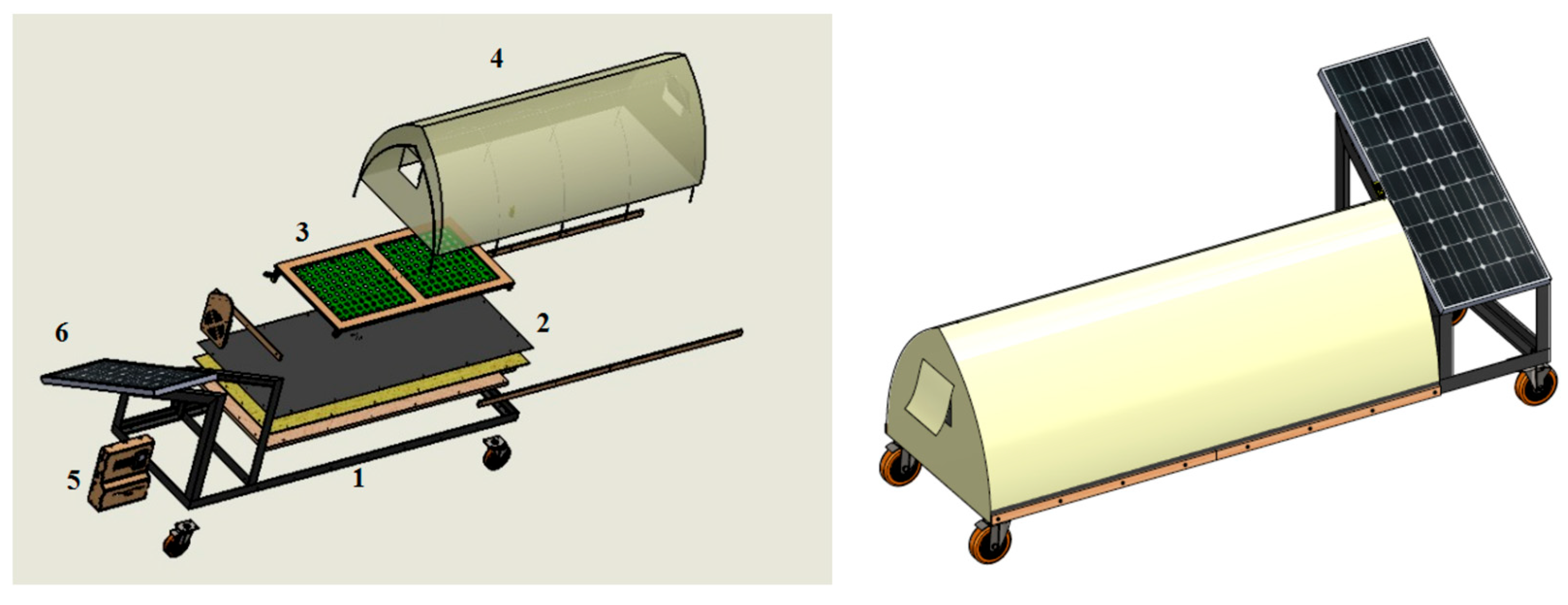

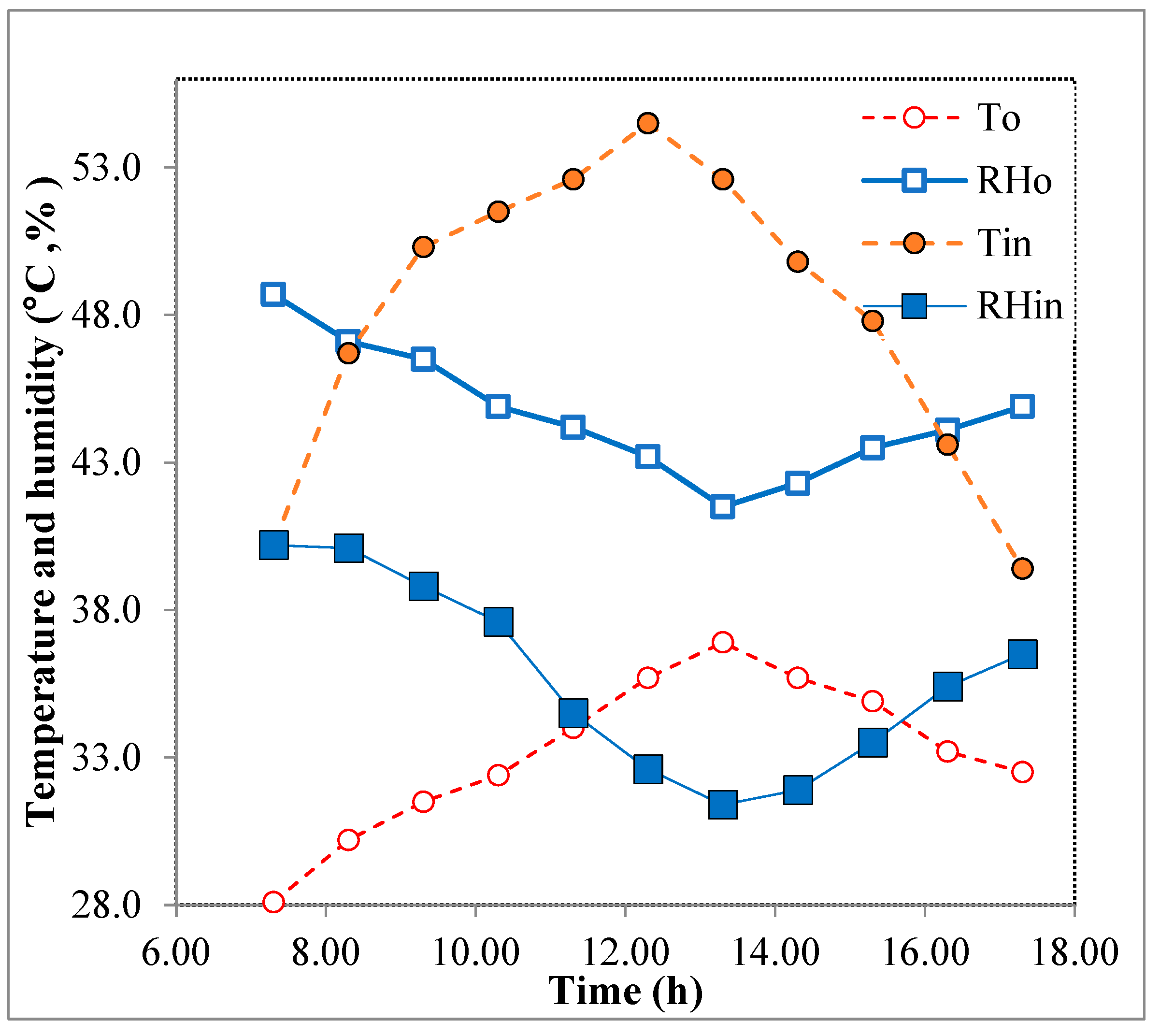
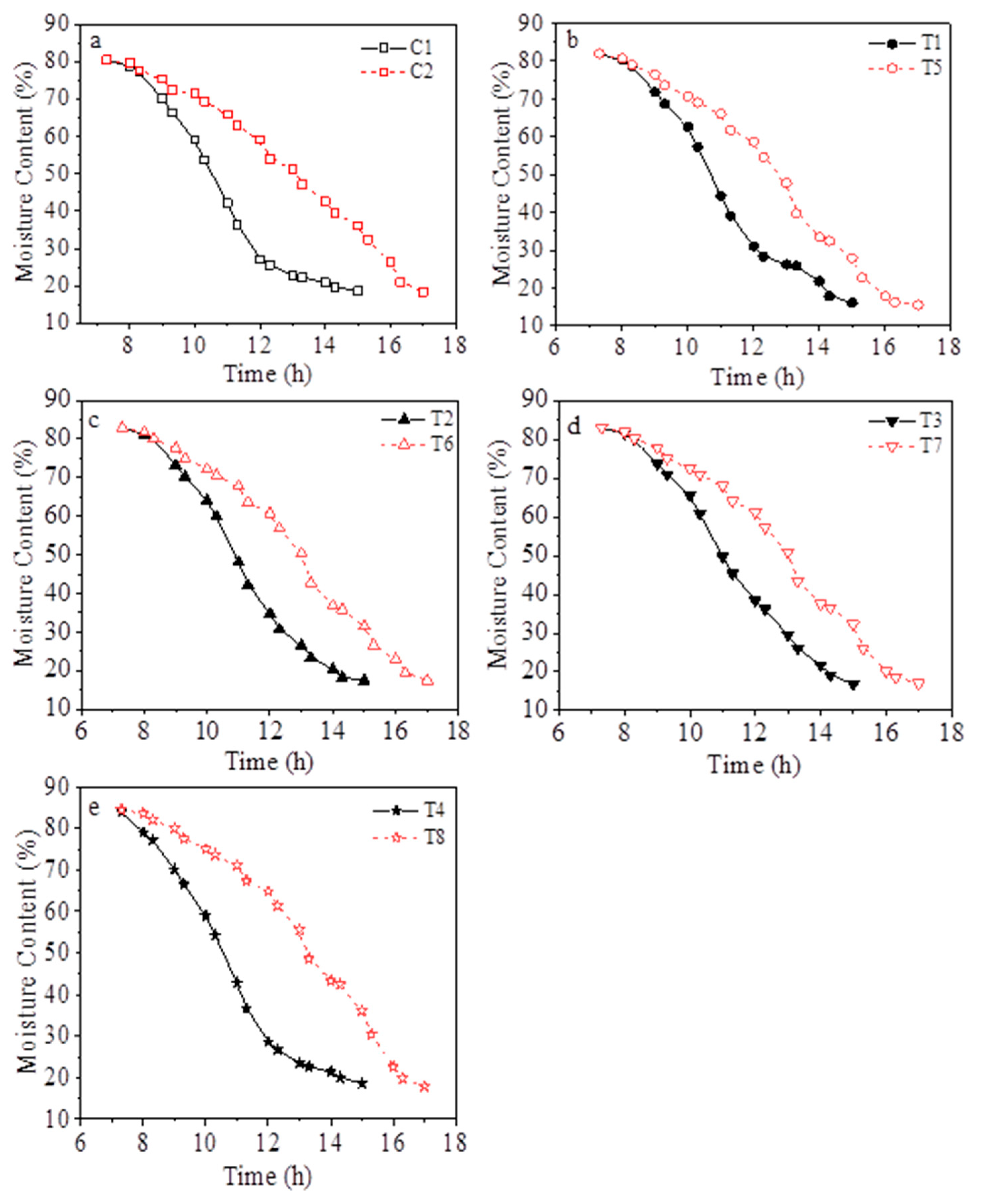
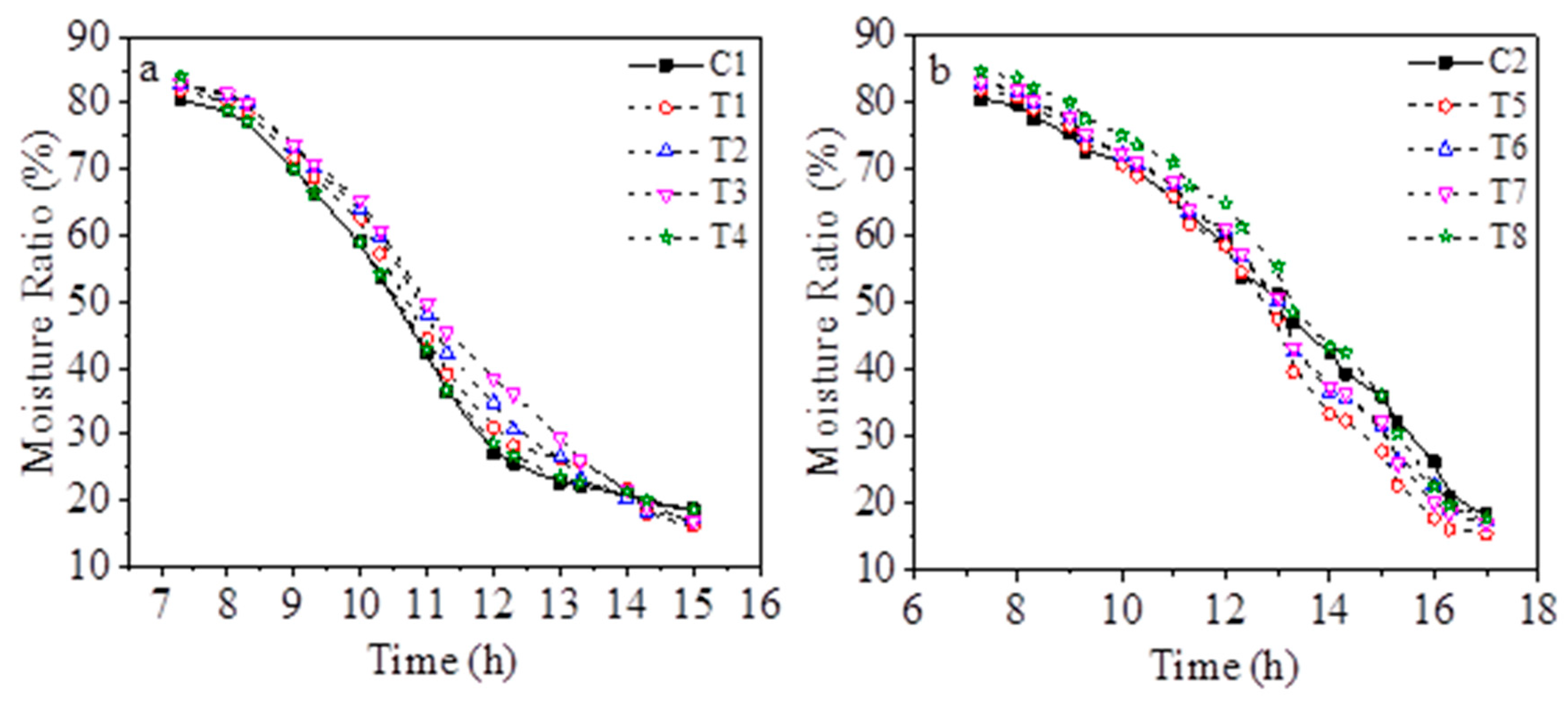

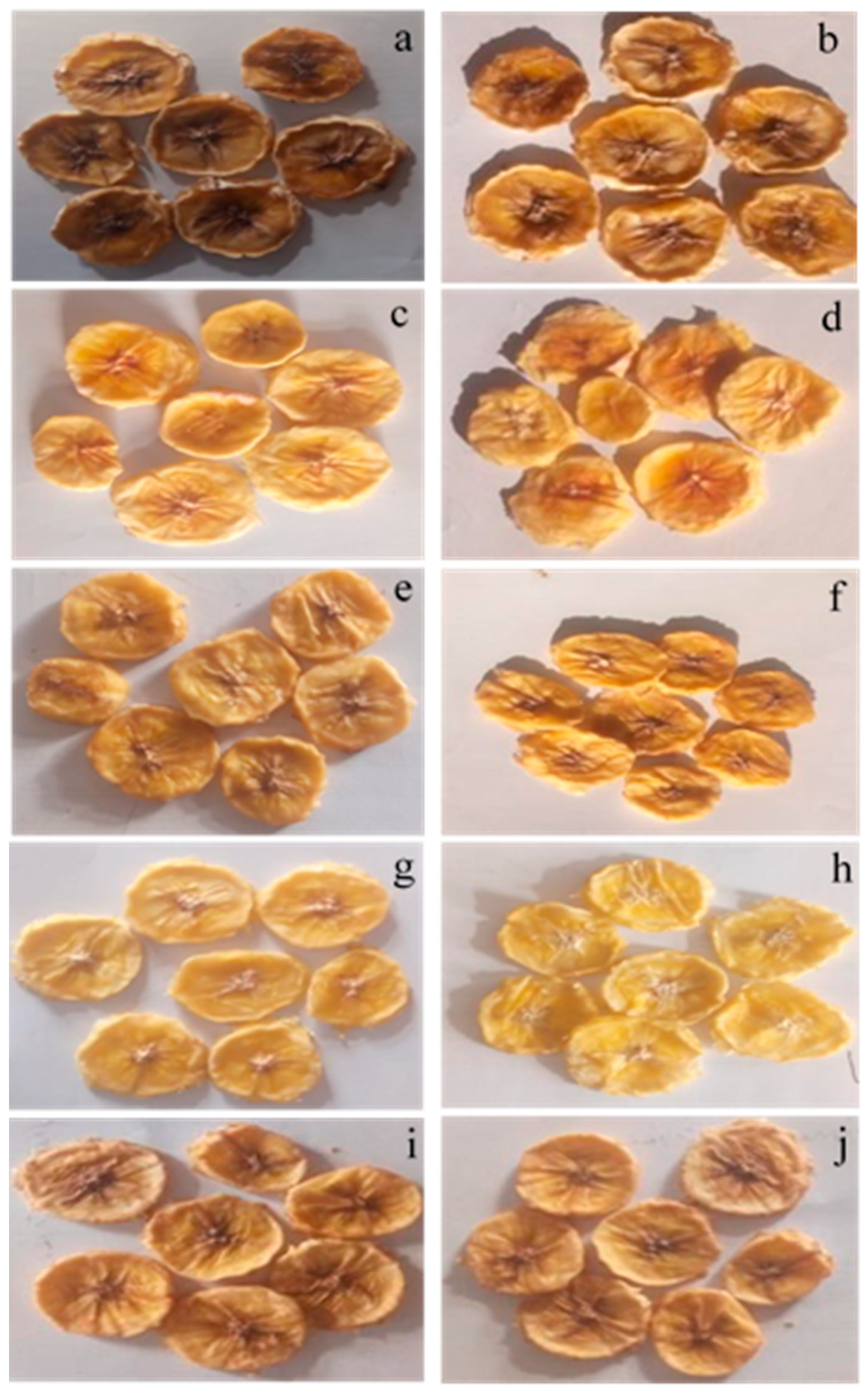
| Parameters | Fresh | Drying Methods | Treatments | ||||
|---|---|---|---|---|---|---|---|
| Control | Citric and Ascorbic Acid | Sucrose | Sodium Bisulphate | Lemon and Acetic Acid | |||
| pH | 5.86 | SD | 5.78 a ±0.14 | 4.66 b ±0.11 | 5.76 a ±0.16 | 5.73 a ±0.17 | 5.35 a ±0.00 |
| TD | 5.58 a ±0.17 | 4.59 b ±0.08 | 5.71 a ±0.14 | 5.69 a ±0.17 | 5.33 a ±0.16 | ||
| Acidity (%) as malic | 0.47 | SD | 0.50 b ±0.05 | 1.08 a ±0.11 | 0.53 b ±0.04 | 0.59 b ±0.02 | 0.98 a ±0.00 |
| TD | 0.55 b ±0.11 | 0.99 a ±0.10 | 0.56 b ±0.04 | 0.57 b ±0.05 | 0.96 a ±0.08 | ||
| Water activity (aw) | 0.972 | SD | 0.692 a ±0.17 | 0.675 a ±0.28 | 0.652 a ±0.11 | 0.668 a ±0.23 | 0.658 a ±0.11 |
| TD | 0.695 a ±0.00 | 0.672 a ±0.00 | 0.658 a ±0.00 | 0.670 a ±0.00 | 0.656 a ±0.00 | ||
| Browning index (O.D) | 0.25 | SD | 0.85 a ±0.28 | 0.60 c ±0.34 | 0.81 ab ±0.11 | 0.56 c ±0.17 | 0.69 bc ±0.23 |
| TD | 0.79 a ±0.07 | 0.61 bc ±0.06 | 0.66 b ±0.09 | 0.50 c ±0.03 | 0.65 b ±0.08 | ||
| Rehydration ratio | ----- | SD | 2.34 b ±0.06 | 2.94 a ±0.08 | 2.43 b ±0.04 | 2.45 b ±0.05 | 2.92 a ±0.06 |
| TD | 2.43 b ±0.10 | 3.12 a ±0.11 | 2.54 b ±0.08 | 2.86 a ±0.10 | 3.08 a ±0.07 | ||
| Parameters | Drying Methods | Fresh | Treatment | ||||
|---|---|---|---|---|---|---|---|
| Control | Citric and Ascorbic Acid | Sucrose | Sodium Bisulphate | Lemon and Acetic Acid | |||
| Reducing sugar | SD | 16.08 | 19.98 b ±0.57 | 19.72 b ±0.46 | 21.02 a ±0.40 | 19.90 b ±0.51 | 19.75 b ±0.69 |
| TD | 20.02 b ±0.69 | 19.75 b ±0.51 | 21.05 a ±0.46 | 19.96 b ±0.75 | 19.80 b ±0.63 | ||
| Total phenolic content mg/kg | SD | 96.91 | 99.09 c ± 1.73 | 113.85 a ± 2.88 | 102.37 c ± 1.15 | 111.98 a ± 0.86 | 106.87 b ± 2.30 |
| TD | 101.76 d ± 0.43 | 115.90 a ± 0.46 | 105.84 c ± 0.75 | 109.69 b ± 1.03 | 108.52 b ± 1.61 | ||
| Ascorbic acid (%) | SD | 44.87 | 65.14 d ± 0.20 | 80.23 ab ± 0.23 | 74.86 c ± 0.46 | 81.16 a ± 0.40 | 79.45 b ± 0.46 |
| TD | 73.21 e ± 0.23 | 83.63 b ± 0.02 | 78.13 d ± 0.51 | 84.95 a ± 0.17 | 81.35 c ± 0.40 | ||
| DPPH (%) | SD | 60.22 | 83.03 c ± 0.57 | 85.00 ab ± 0.69 | 85.57 a ± 0.46 | 85.06 ab ± 0.86 | 84.11 b ± 0.75 |
| TD | 83.28 c ± 0.51 | 86.61 a ± 0.57 | 86.03 ab ± 0.44 | 85.73 ab ± 0.69 | 84.34 b ± 0.63 | ||
| Sensory Properties | Drying Methods | Treatment | ||||
|---|---|---|---|---|---|---|
| Control | Citric + Ascorbic Acid | Sucrose | Sodium Bisulphate | Lemon + Acetic Acid | ||
| Color | SD | 5.00 d ±0.06 | 8.50 b ±0.07 | 7.00 c ±0.05 | 9.00 a ±0.12 | 7.00 c ±0.11 |
| TD | 6.00 e ±0.07 | 8.50 b ±0.12 | 8.00 c ±0.15 | 9.50 a ±0.12 | 7.00 d ±0.07 | |
| Taste | SD | 6.00 c ±0.05 | 7.00 b ±0.07 | 8.00 a ±0.12 | 6.00 c ±0.06 | 5.25 d ±0.06 |
| TD | 6.00 c ±0.10 | 7.00 b ±0.15 | 8.00 a ±0.20 | 6.00 c ±0.07 | 5.50 d ±0.12 | |
| Odor | SD | 5.00 d ±0.05 | 6.50 b ±0.12 | 7.50 a ±0.12 | 6.50 b ±0.10 | 6.00 c ±0.07 |
| TD | 5.80 d ±0.20 | 6.50 c ±0.07 | 8.00 a ±0.20 | 7.00 b ±0.18 | 6.00 d ±0.12 | |
| Texture | SD | 5.00 d ±0.07 | 7.00 b ±0.20 | 7.00 b ±0.15 | 8.00 a ±0.25 | 6.50 c ±0.12 |
| TD | 5.00 d ±0.12 | 7.00 c ±0.18 | 8.00 b ±0.18 | 9.00 a ±0.25 | 7.00 c ±0.19 | |
| Overall acceptability | SD | 5.25 c ±0.20 | 7.25 a ±0.12 | 7.38 a ±0.09 | 7.38 a ±0.10 | 6.13 b ±0.03 |
| TD | 5.75 d ±0.19 | 7.25 b ±0.06 | 8.00 a ±0.25 | 7.88 a ±0.22 | 6.38 c ±0.09 | |
Disclaimer/Publisher’s Note: The statements, opinions and data contained in all publications are solely those of the individual author(s) and contributor(s) and not of MDPI and/or the editor(s). MDPI and/or the editor(s) disclaim responsibility for any injury to people or property resulting from any ideas, methods, instructions or products referred to in the content. |
© 2023 by the authors. Licensee MDPI, Basel, Switzerland. This article is an open access article distributed under the terms and conditions of the Creative Commons Attribution (CC BY) license (https://creativecommons.org/licenses/by/4.0/).
Share and Cite
Abd El-Wahhab, G.G.; Sayed, H.A.A.; Abdelhamid, M.A.; Zaghlool, A.; Nasr, A.; Nagib, A.; Bourouah, M.; Abd-ElGawad, A.M.; Rashad, Y.M.; Hafez, M.; et al. Effect of Pre-Treatments on the Qualities of Banana Dried by Two Different Drying Methods. Sustainability 2023, 15, 15112. https://doi.org/10.3390/su152015112
Abd El-Wahhab GG, Sayed HAA, Abdelhamid MA, Zaghlool A, Nasr A, Nagib A, Bourouah M, Abd-ElGawad AM, Rashad YM, Hafez M, et al. Effect of Pre-Treatments on the Qualities of Banana Dried by Two Different Drying Methods. Sustainability. 2023; 15(20):15112. https://doi.org/10.3390/su152015112
Chicago/Turabian StyleAbd El-Wahhab, Gomaa G., Hassan A. A. Sayed, Mahmoud A. Abdelhamid, Ayman Zaghlool, Ali Nasr, Ashraf Nagib, Mohamed Bourouah, Ahmed M. Abd-ElGawad, Younes M. Rashad, Mohamed Hafez, and et al. 2023. "Effect of Pre-Treatments on the Qualities of Banana Dried by Two Different Drying Methods" Sustainability 15, no. 20: 15112. https://doi.org/10.3390/su152015112
APA StyleAbd El-Wahhab, G. G., Sayed, H. A. A., Abdelhamid, M. A., Zaghlool, A., Nasr, A., Nagib, A., Bourouah, M., Abd-ElGawad, A. M., Rashad, Y. M., Hafez, M., & Taha, I. M. (2023). Effect of Pre-Treatments on the Qualities of Banana Dried by Two Different Drying Methods. Sustainability, 15(20), 15112. https://doi.org/10.3390/su152015112












